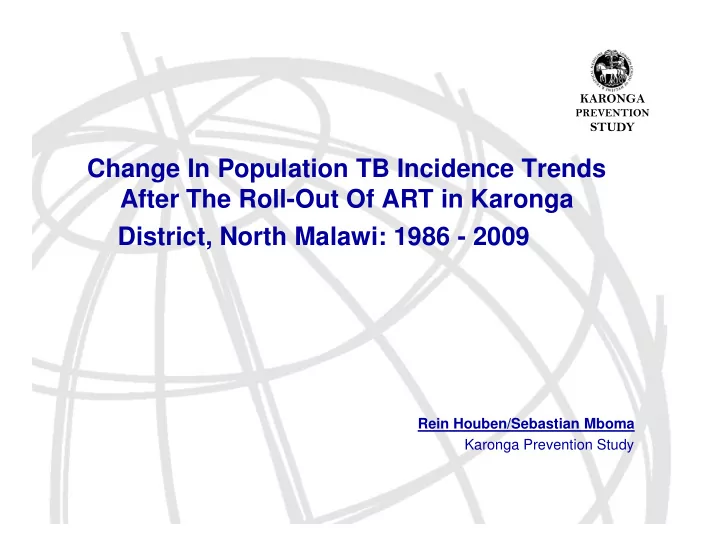

������� ����������� ����� Change In Population TB Incidence Trends After The Roll-Out Of ART in Karonga District, North Malawi: 1986 - 2009 Rein Houben/Sebastian Mboma Karonga Prevention Study
TB incidence over time ������� ����������� ����� ART?? 400 + TB (n/100,000/year South Africa 350 HIV Zimbabwe 300 Botswana 250 Incidence of SS+ TB Kenya Kenya 200 Malawi 150 Tanzania 100 Senegal Cameroon 50 Benin 0 1990 1995 2000 2005 2010
Literature ������� ����������� ����� Williams & Dye (Science – 2003): early start, high coverage and • compliance necessary for ART to reduce TB burden in population Studies have suggested • – Relative incidence of TB lower amongst patients receiving ART (in CD4 strata) – Late starters (CD4<100) remain at elevated risk of TB – Late starters (CD4<100) remain at elevated risk of TB • Limitations – Most studies are done in intensely supervised study settings – not representative of rural Africa – Few cases of TB – No HIV negative or positive comparison group – Effect of ART on TB incidence in wider population
Research Questions ������� ����������� ����� • What is the relative incidence of TB by HIV/ART status? • What is the effect of the ART roll-out on TB • What is the effect of the ART roll-out on TB incidence trends in Karonga District?
Karonga Prevention Study ������� ����������� ����� TB epidemiological studies since 1985 • All TB cases – Laboratory tests – Demographic information – HIV status (from 1988) – HIV status (from 1988) • ART since July 2005 – Low level of clinical and laboratory support
Population denominators ������� ����������� ����� Adult population size • Census in 1988, 1998, 2008 HIV prevalence in population • Mathematical model based on population data • Mathematical model based on population data for HIV prevalence White R.G. et al (Epi Inf, 2007) Uptake of ART in population • ART clinic registers • Person years on ART in Karonga – Recently started on ART --> 6 months or less – On ART for longer period --> more than 6 months
TB cases ������� ����������� ����� • Main analysis – Only new SS+ pulmonary TB cases since Jan 1986 – Aug 2009 (Lab confirmed - at least 1 positive culture or 2 separate smears positive for Mtb) • Sensitivity analyses on different TB case populations • HIV and ART status – From linked KPS database of previously recorded data – Missing HIV and/or ART status were imputed using MICE (Multiple imputation using Chained Equations)
Analysis ������� ����������� ����� • Relative TB incidence (July 2005 – Aug 2009) – Rate ratios by HIV status – Rate ratios By HIV/ART status • Incidence trends analysis – Piecewise regression to test for change in trend between 1997 – 2005 and 2005 – Aug 2009 periods
Relative incidence (05 – 09) ������� ����������� ����� �������� ����������� ���������������� � �� ��� ����� �������� � ������� ��� ������ �� ���� ���� � !��������� "�� #��### �" " � !��������� � !��������� ��$ ��$ ��"�% ��"�% ��� ��� "������&"%�"�'"��$"( "������&"%�"�'"��$"( "%��$��&�����' "����( "%��$��&�����' "����( � !)�����*+ "�� #"�%� ��% " " � !),-�.��*+ �$ "��# "��� ������&��$��' ""�%�( ���"�&���#�' $���( � !)�/�.��*+ �� ���� �$� ������&"�$#�' ���#( �����&"����' ����( *RR’s adjusted for age group (15-24, 25-34, 35-44, 45-54, >=55) and sex Note: The imputed data show roughly the same results, which suggests that the imputation did not do anything strange or introduce more bias .
Overall ������� ����������� �����
All cases & HIV negative ������� ����������� �����
HIV positive ������� ����������� �����
Change in incidence trend ������� ����������� ����� RR express linear annual change in TB incidence, baseline is first year of the period (1997 or 2005). Imputed datasets were used. ������ �������������� ������ � � ������������� � ��! � � "������� # **�&$#0�� ( **�&$#0�� ( �������� %�$��&%�$"�' %�$#( "�%"�&%�$��' "�%�( %�%� � !� %�$"�&%����' %�$#( "�%$�&%�$$�' "�"$( %�%%# �������� � !� %�$��&%�$��' %�$$( %�$$�&%�$��' "�%�( %�#� �������� *p-value for change in trend in 2005.
Summary of results ������� ����������� ����� • Relative incidence – High incidence early after initiation ART – Decreases with time, but still elevated • Incidence trend • Incidence trend – Decrease until introduction ART, when it plateaus • Imputation – Does not affect relative incidence estimates – Corrects bias in incidence trends
Limitations ������� ����������� ����� • No CD4 counts – Low CD4 at start ART would explain high relative incidences • Population estimates are always a bit • Population estimates are always a bit uncertain • HIV estimates – Not include effect ART, but fitted new data reasonably well.
Interpretation ������� ����������� ����� • Well supported DOTS programme controlling TB incidence – Area with generalised HIV and moderate TB transmission • Advent of ART coincided with plateau in TB incidence – Affects HIV positive and HIV negative population – Affects HIV positive and HIV negative population – Very high risk of TB in HIV patients starting ART (too) late • Incidence trends – Extra TB cases following roll-out of ART • Direct effect on incidence in HIV positive population • Indirect effect in HIV negative population – Indirect effect difficult to quantify
Implications/Recommendations ������� ����������� ����� • Start ART earlier • Further collaboration/Integration of TB and ART programmes ART programmes • Intensified case finding in high risk population of patients receiving ART
Acknowledgements ������� ����������� ����� Patients and clinical staff in Malawi KPS colleagues Funders Funders Audience
������� ����������� ����� THANK YOU THANK YOU
Recommend
More recommend